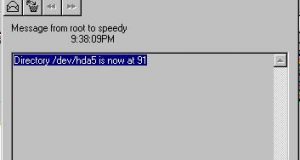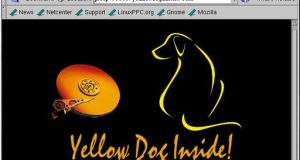Travis Metcalfe Ed Nather Issue #65, September 1999 Astronomers at the University of Texas-Austin are using the ideas of Charles Darwin to learn about the interior of white dwarf stars—using a minimal parallel Linux cluster tailored specifically to their application. Astronomers worry about how stars work. Our current models describe stars as huge, hot gasballs, bloated and made luminous by ...
Read More »Demo Blog With Map
Cooking with Linux—The French Connection
Marcel Gagné Issue #65, September 1999 Mr. Gagné provides us with several recipes from his famed French restaurant. Allo, and welcome to Chez Marcel, home of fine French Linux cooking. Please take a seat. If you have not already done so, I would like you to read this article with a somewhat exaggerated French accent since that is the way ...
Read More »Trying to Install OpenLinux
Best of Technical Support Various Issue #76, August 2000 Our experts answer your technical questions. Two Monitors? Is it possible in Linux (I don’t care which distribution, I mean the system architecture) to have two screens, i.e., two monitors on the same machine? Also with two graphics cards, of course. Is it possible to have them running together, either in ...
Read More »Linux Finance Programs Review
Ralph Krause Issue #76, August 2000 We continually hear “I would only use Linux except I need to …”. One of those missing pieces has been to run Quicken. Find out what programs are available for Linux that offer an alternative to Quicken. As Linux finds its way onto more and more computers, the need for a broader range of ...
Read More »Yellow Dog Linux on the iMac
Stew Benedict Issue #76, August 2000 A guide to installing and running YDL on a power PC. First, a disclaimer: I’m not a fanatic Macintosh guy. I got a Macintosh late in my computing career, just last year in fact—an iMac. I was working on a cross-platform Tcl/Tk project, and I was getting pretty involved in fine-tuning the GUI for ...
Read More »LinuxPPC on the Macintosh PowerBook
Richard Kinne Issue #76, August 2000 Graphical installation environments help Macintosh play better than ever with Linux. To say Linux has undergone a growth in popularity over the last few years is, of course, an understatement. One cannot read any computer-related medium today without being bombarded with news and views on the Linux operating system. Some would even have you ...
Read More »Recovery after Partitioning
Best of Technical Support Various Issue #75, July 2000 Our experts answer your technical questions. Configuring ipchains Current setup: I’m running ipchains as a firewall and to proxy my other machine to the Web via DSL. This Linux firewall has two NIC cards: one with a public IP address, the other on my private 10.100.100 network. I have a web ...
Read More »A GNU/Linux Wristwatch Videophone
Steve Mann Issue #75, July 2000 This fully fuctioning prototype, designed and built by Steve Mann in 1998, was demonstrated in 1999, and later used to deliver a videoconference at ISSCC 2000. Videophone wristwatches are a science-fiction concept that is here today. The two key inventive concepts that make this new technology possible are: The use of a body-worn computer ...
Read More »THOR: A Versatile Commodity Component of Supercomputer Development
Robert A. Davis Issue #75, July 2000 CERN continues to use Linux as their OS of choice for modeling and simulation studies. The world’s highest energy particle accelerator, the Large Hadron Collider (LHC), is presently being constructed at the European Center for Particle Physics Research (CERN) near Geneva, Switzerland. The planned date for first collisions is 2005. Since the demise ...
Read More »Linux kernel and the GNU tools
Juergen Kahrs Issue #75, July 2000 All that is real is reasonable, and all that is reasonable is real. —G.W.F. Hegel, 1770-1831 Scientists and engineers were among the first to notice what a powerful combination the Linux kernel and the GNU tools are. Thus, it is no surprise that it was the sober scientists who started replacing expensive supercomputers with ...
Read More » Linux, Linux OS, Free Linux Operating System, Linux India Linux, Linux OS,Free Linux Operating System,Linux India supports Linux users in India, Free Software on Linux OS, Linux India helps to growth Linux OS in India
Linux, Linux OS, Free Linux Operating System, Linux India Linux, Linux OS,Free Linux Operating System,Linux India supports Linux users in India, Free Software on Linux OS, Linux India helps to growth Linux OS in India









